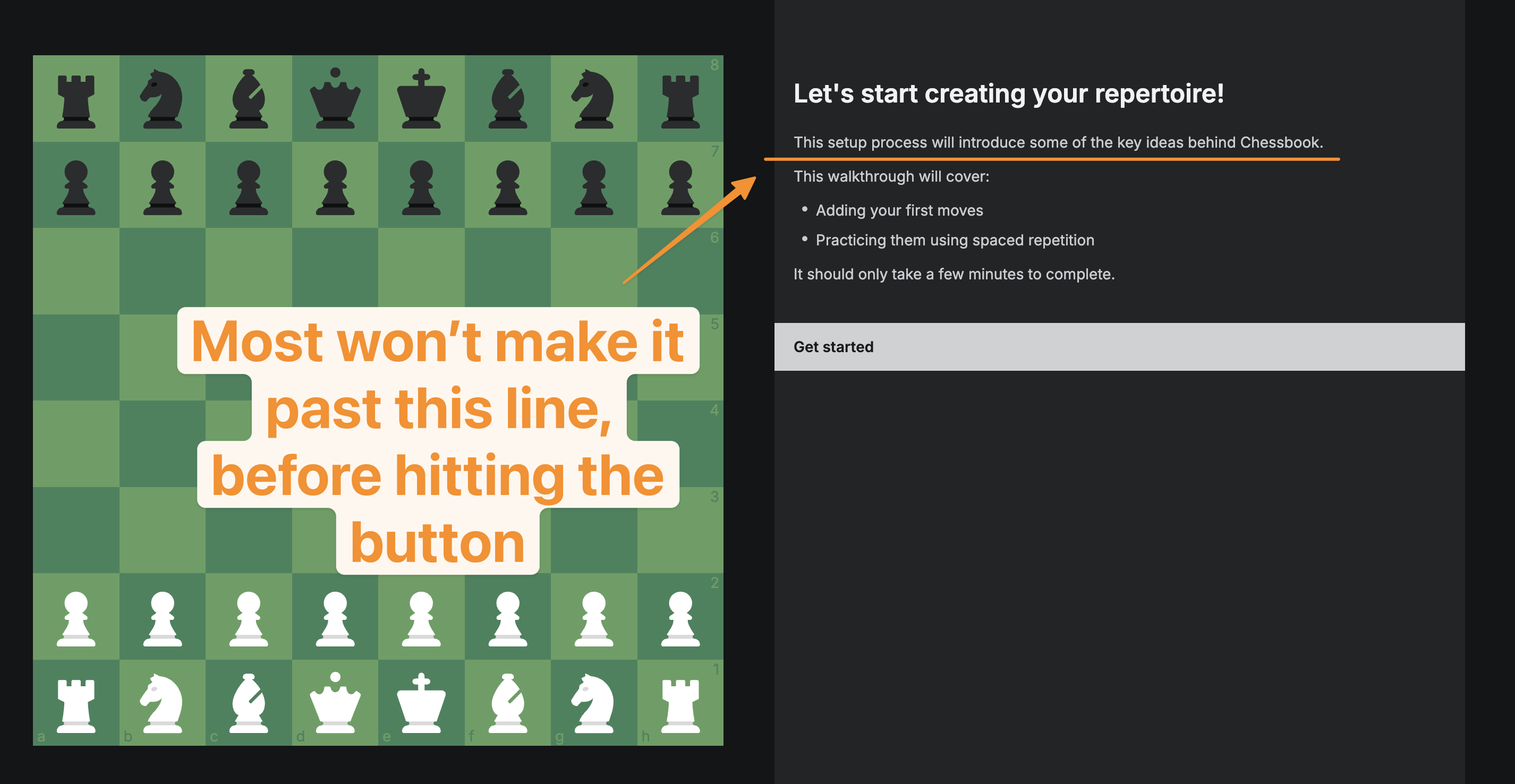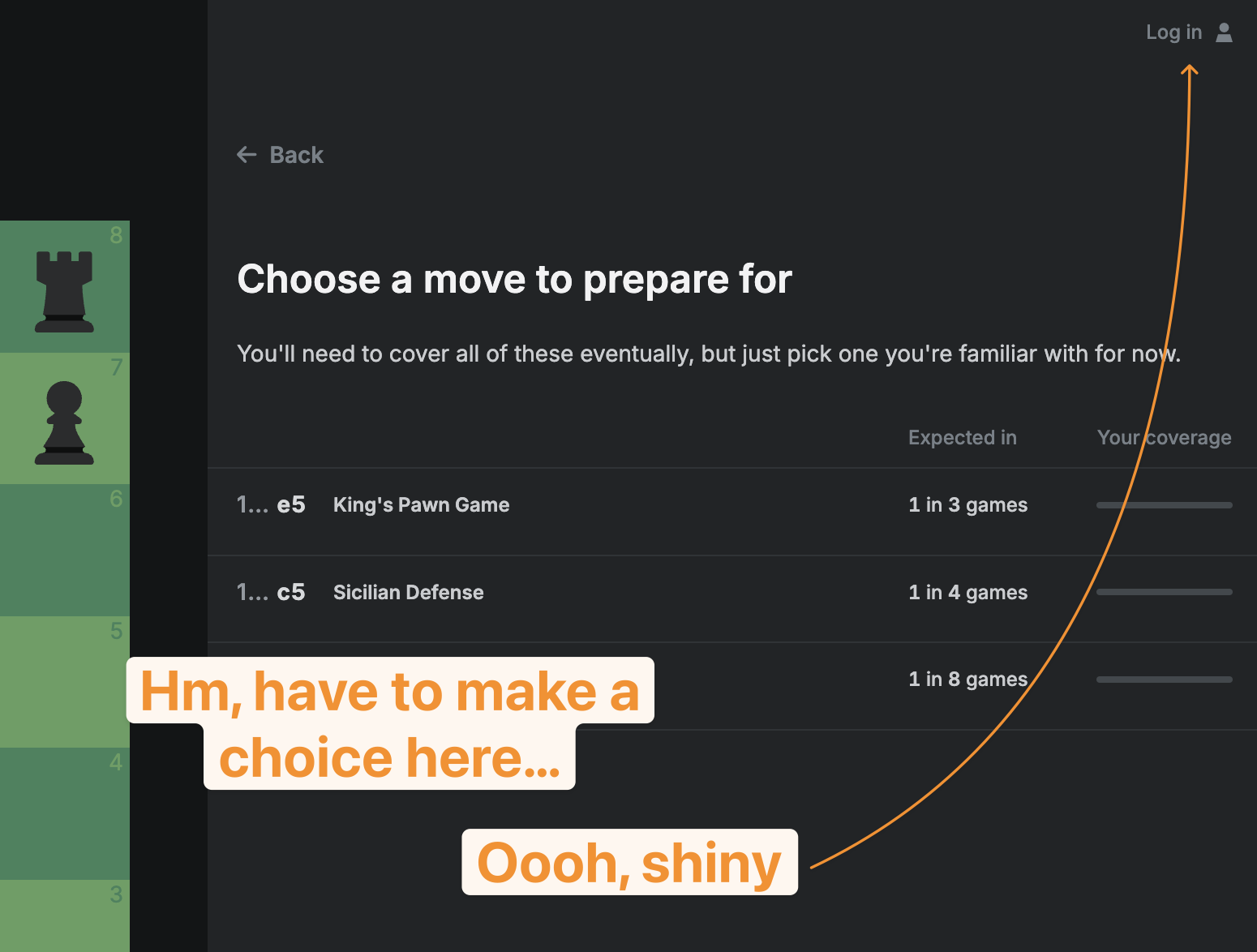Treat your onboarding users like toddlers
4 minutes
Dec 12, 2024One of the biggest realizations I’ve had when building Chessbook is that onboarding a user is really hard. A user that’s coming in from some generic marketing, or from a blog post they found, or from organic search… well, the closest mental model is that they’re precocious toddlers.
They won’t read more than a couple sentences of explanation. Usually they’ll skip that entirely and just hit the shiniest button. You have to keep snapping your fingers in front of their face every 10 seconds or so, or they’ll walk away close the tab. If they experience any friction, there’s about a 50/50 chance of them just deciding to go play with a different toy scroll Twitter instead.
I ain’t reading all that

Your users aren’t actual toddlers – they can read. But they won’t. Anything more than a sentence and you’ll lose them. They’ll skip right over the nice explanatory text you’ve written, then go leave a 1-star review on the App Store saying your app is confusing and they don’t get it. If you absolutely must have users read something, it should be condensed as much as humanly possible, because people won’t be giving it more than a cursory glance.
Why is this taking so long (“so long” ≃ 10 seconds)
Until a few months ago, we asked users to add a representative line of opening prep during onboarding, then review it. Users got through the part where they add the line, and then often dropped off while reviewing. Reviewing really didn’t take long – about a minute. But a minute is an hour in toddler time. We reduced the initial review session down to 3 moves for beginners, and saw nearly a 50% bump in conversion on that step.
Also, your users are going to be way slower than you in onboarding. So don’t use yourself as the measuring stick here. If you do, then apply a similar rule as teachers – time yourself taking the test, then triple it.
Decisions are draining
You know that theory of minimizing “decision fatigue” – popular with a certain sect of Silicon Valley engineers years ago? As if some non-negligible portion of Steve Jobs’ success came from not having to pick which turtleneck he was going to wear that day? I don’t know if that’s been officially debunked, but decision fatigue for your onboarding users is absolutely real.
Any decision adds up here. A simple “does this look good” prompt, with the option to go back and change your opening line that you’ve entered, resulted in nearly a 20% drop in conversion. Users weren’t thinking of questioning themselves before that, but now you’ve asked them, and they have a decision to make.
The difficulty of the decision certainly plays a role here too. Choosing an opening move for a beginner chess player can take some thought, whereas an expert knows what he plays already. So you may need different personas here to determine the difficulty of the decision you’re asking a user to make.
Ooo, shiny

If there’s any sort of friction – a loader, a decision to be made, too much text to be read – some non-negligible portion of users will just go click on something. Anything. Doesn’t matter what. We had plenty of people get out of the happy path of onboarding because instead of choosing a move, they clicked our “Log in” button instead (no, they didn’t have an account). Or they clicked to “analyze this position”, taking them out of our site and never returning. We removed those button once onboarding was in progress. Our conversion improved and we had fewer users coming into our Discord asking “how do I use this thing?”
Advice
App users are way easier to onboard
There’s something about downloading an app that makes you give it way more of a shot. Our onboarding conversion rate is about 15% on the web, and about 60% on our apps. Identical onboarding process.
Try to maximize the motivation of users coming in
Not all users are created equal, for Chessbook there’s sort of a hierarchy of onboarding users:
- Word of mouth referrals: These will really give the site a chance, and spend some time experimenting with it. Most similar to what you’d see in user testing.
- Long-form advertisements (ex: YouTube channel sponsorships): A bit of a dip in attention span, but still very much possible to onboard.
- Reddit ads, X ads, Google ads, etc: Toddlers.
Your list will be different, but the more you can get users from the top of your hierarchy, the better off you’ll be.
Less is more
Try to offload as much as possible to your product. Not only is it hard to get people through a lot of onboarding, but having a lot of it can be a sign that your product needs to be more intuitive.
If you play games, my PSN is mbuffett, always looking for fun people to play with.
If you're into chess, I've made a repertoire builder. It uses statistics from hundreds of millions of games at your level to find the gaps in your repertoire, and uses spaced repetition to quiz you on them.
If you want to support me, you can buy me a coffee.